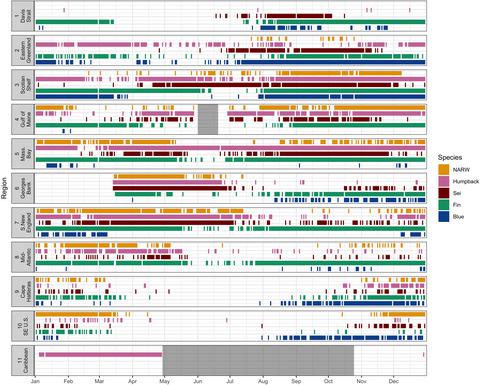当前位置:
X-MOL 学术
›
Glob. Change Biol.
›
论文详情
Our official English website, www.x-mol.net, welcomes your feedback! (Note: you will need to create a separate account there.)
Exploring movement patterns and changing distributions of baleen whales in the western North Atlantic using a decade of passive acoustic data.
Global Change Biology ( IF 11.6 ) Pub Date : 2020-05-25 , DOI: 10.1111/gcb.15191 Genevieve E Davis 1, 2 , Mark F Baumgartner 3 , Peter J Corkeron 4 , Joel Bell 5 , Catherine Berchok 6 , Julianne M Bonnell 7 , Jacqueline Bort Thornton 5 , Solange Brault 2 , Gary A Buchanan 8 , Danielle M Cholewiak 1 , Christopher W Clark 9 , Julien Delarue 10 , Leila T Hatch 11 , Holger Klinck 9 , Scott D Kraus 4 , Bruce Martin 10 , David K Mellinger 12 , Hilary Moors-Murphy 13 , Sharon Nieukirk 12 , Douglas P Nowacek 14, 15 , Susan E Parks 16 , Dawn Parry 9 , Nicole Pegg 7 , Andrew J Read 14 , Aaron N Rice 9 , Denise Risch 17 , Alyssa Scott 7 , Melissa S Soldevilla 18 , Kathleen M Stafford 19 , Joy E Stanistreet 13 , Erin Summers 20 , Sean Todd 21 , Sofie M Van Parijs 1
Global Change Biology ( IF 11.6 ) Pub Date : 2020-05-25 , DOI: 10.1111/gcb.15191 Genevieve E Davis 1, 2 , Mark F Baumgartner 3 , Peter J Corkeron 4 , Joel Bell 5 , Catherine Berchok 6 , Julianne M Bonnell 7 , Jacqueline Bort Thornton 5 , Solange Brault 2 , Gary A Buchanan 8 , Danielle M Cholewiak 1 , Christopher W Clark 9 , Julien Delarue 10 , Leila T Hatch 11 , Holger Klinck 9 , Scott D Kraus 4 , Bruce Martin 10 , David K Mellinger 12 , Hilary Moors-Murphy 13 , Sharon Nieukirk 12 , Douglas P Nowacek 14, 15 , Susan E Parks 16 , Dawn Parry 9 , Nicole Pegg 7 , Andrew J Read 14 , Aaron N Rice 9 , Denise Risch 17 , Alyssa Scott 7 , Melissa S Soldevilla 18 , Kathleen M Stafford 19 , Joy E Stanistreet 13 , Erin Summers 20 , Sean Todd 21 , Sofie M Van Parijs 1
Affiliation

|
Six baleen whale species are found in the temperate western North Atlantic Ocean, with limited information existing on the distribution and movement patterns for most. There is mounting evidence of distributional shifts in many species, including marine mammals, likely because of climate‐driven changes in ocean temperature and circulation. Previous acoustic studies examined the occurrence of minke (Balaenoptera acutorostrata ) and North Atlantic right whales (NARW; Eubalaena glacialis ). This study assesses the acoustic presence of humpback (Megaptera novaeangliae ), sei (B. borealis ), fin (B. physalus ), and blue whales (B. musculus ) over a decade, based on daily detections of their vocalizations. Data collected from 2004 to 2014 on 281 bottom‐mounted recorders, totaling 35,033 days, were processed using automated detection software and screened for each species' presence. A published study on NARW acoustics revealed significant changes in occurrence patterns between the periods of 2004–2010 and 2011–2014; therefore, these same time periods were examined here. All four species were present from the Southeast United States to Greenland; humpback whales were also present in the Caribbean. All species occurred throughout all regions in the winter, suggesting that baleen whales are widely distributed during these months. Each of the species showed significant changes in acoustic occurrence after 2010. Similar to NARWs, sei whales had higher acoustic occurrence in mid‐Atlantic regions after 2010. Fin, blue, and sei whales were more frequently detected in the northern latitudes of the study area after 2010. Despite this general northward shift, all four species were detected less on the Scotian Shelf area after 2010, matching documented shifts in prey availability in this region. A decade of acoustic observations have shown important distributional changes over the range of baleen whales, mirroring known climatic shifts and identifying new habitats that will require further protection from anthropogenic threats like fixed fishing gear, shipping, and noise pollution.
中文翻译:

使用十年来的被动声波数据,探索北大西洋西部鲸鱼的运动方式和分布变化。
在北大西洋温带西部发现了六种鲸鱼物种,但大多数物种的分布和活动模式信息有限。越来越多的证据表明,包括海洋哺乳动物在内的许多物种的分布变化,可能是由于气候驱动的海洋温度和环流变化所致。先前的声学研究检查了小须鲸(Balaenoptera acutorostrata)和北大西洋右鲸(NARW; Eubalaena glacialis)的发生。本研究评估驼背(的声学存在学名Megaptera novaeangliae),SEI(B.北极光),翅片(B. physalus)和蓝鲸(B.家鼠),基于每天对其发声的检测。使用自动检测软件处理了2004年至2014年在281个底部安装的记录仪上收集的数据,总计35,033天,并对每个物种的存在进行了筛选。一份有关NARW声学的已发表研究表明,在2004–2010年和2011–2014年之间,发生模式发生了显着变化。因此,这里检查了这些相同的时间段。从美国东南部到格陵兰都有这四个物种。加勒比海也有座头鲸。在冬季,所有物种都分布在所有地区,这表明鲸鱼在这几个月中分布广泛。在2010年之后,每个物种的声音发生均发生了显着变化。类似于NARW,在2010年之后,大西洋中部地区的鲸鱼的声波发生率更高。2010年之后,在研究区域的北纬地区更频繁地发现有鳍,蓝鲸和鲸。 2010年以后的斯科蒂尔货架区,与该地区猎物可利用量的记录相匹配。十年的声学观测表明,在须鲸的分布范围内,重要的分布发生了变化,反映了已知的气候变化并确定了新的栖息地,这些栖息地将需要进一步保护,以免受人为威胁,例如固定渔具,运输和噪声污染。在2010年之后,在斯科塔夫大陆架地区发现的所有四种物种都较少,与该地区猎物可利用量的记录变化相符。十年的声学观测表明,在须鲸的分布范围内,重要的分布发生了变化,反映了已知的气候变化并确定了新的栖息地,这些栖息地将需要进一步保护,以免受人为威胁,例如固定渔具,运输和噪声污染。在2010年之后,在斯科塔夫大陆架地区发现的所有四种物种都较少,与该地区猎物可利用量的记录变化相符。十年的声学观测表明,在须鲸的分布范围内,重要的分布发生了变化,反映了已知的气候变化并确定了新的栖息地,这些栖息地将需要进一步保护,以免受人为威胁,例如固定渔具,运输和噪声污染。
更新日期:2020-05-25
中文翻译:

使用十年来的被动声波数据,探索北大西洋西部鲸鱼的运动方式和分布变化。
在北大西洋温带西部发现了六种鲸鱼物种,但大多数物种的分布和活动模式信息有限。越来越多的证据表明,包括海洋哺乳动物在内的许多物种的分布变化,可能是由于气候驱动的海洋温度和环流变化所致。先前的声学研究检查了小须鲸(Balaenoptera acutorostrata)和北大西洋右鲸(NARW; Eubalaena glacialis)的发生。本研究评估驼背(的声学存在学名Megaptera novaeangliae),SEI(B.北极光),翅片(B. physalus)和蓝鲸(B.家鼠),基于每天对其发声的检测。使用自动检测软件处理了2004年至2014年在281个底部安装的记录仪上收集的数据,总计35,033天,并对每个物种的存在进行了筛选。一份有关NARW声学的已发表研究表明,在2004–2010年和2011–2014年之间,发生模式发生了显着变化。因此,这里检查了这些相同的时间段。从美国东南部到格陵兰都有这四个物种。加勒比海也有座头鲸。在冬季,所有物种都分布在所有地区,这表明鲸鱼在这几个月中分布广泛。在2010年之后,每个物种的声音发生均发生了显着变化。类似于NARW,在2010年之后,大西洋中部地区的鲸鱼的声波发生率更高。2010年之后,在研究区域的北纬地区更频繁地发现有鳍,蓝鲸和鲸。 2010年以后的斯科蒂尔货架区,与该地区猎物可利用量的记录相匹配。十年的声学观测表明,在须鲸的分布范围内,重要的分布发生了变化,反映了已知的气候变化并确定了新的栖息地,这些栖息地将需要进一步保护,以免受人为威胁,例如固定渔具,运输和噪声污染。在2010年之后,在斯科塔夫大陆架地区发现的所有四种物种都较少,与该地区猎物可利用量的记录变化相符。十年的声学观测表明,在须鲸的分布范围内,重要的分布发生了变化,反映了已知的气候变化并确定了新的栖息地,这些栖息地将需要进一步保护,以免受人为威胁,例如固定渔具,运输和噪声污染。在2010年之后,在斯科塔夫大陆架地区发现的所有四种物种都较少,与该地区猎物可利用量的记录变化相符。十年的声学观测表明,在须鲸的分布范围内,重要的分布发生了变化,反映了已知的气候变化并确定了新的栖息地,这些栖息地将需要进一步保护,以免受人为威胁,例如固定渔具,运输和噪声污染。



























 京公网安备 11010802027423号
京公网安备 11010802027423号